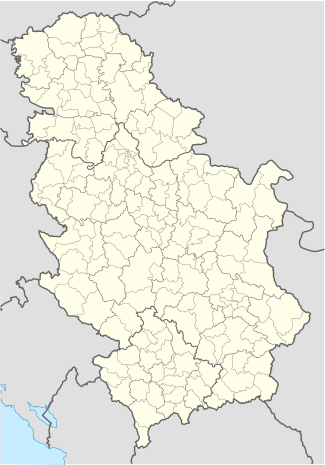Vinča
| Vinča | |
|---|---|
| Suburban settlement | |
 | |
 Vinča | |
| Coordinates: 44°45′20″N 20°36′47″E / 44.75556°N 20.61306°E | |
| Country |
|
| Time zone | CET (UTC+1) |
| • Summer (DST) | CEST (UTC+2) |
Vinča (Serbian: Винча, IPA: [ʋîːntʃa]) is a suburban settlement of Belgrade, the capital of Serbia. It is part of the municipality of Grocka. Vinča-Belo Brdo, an important archaeological site that gives its name to the Neolithic culture, is located in the village.
Location
Vinča is located on the confluence of the Bolečica river into the Danube, on the Danube's right bank, 13 km east of Belgrade and 15 km west of its own municipal seat of Grocka. It is situated along the stream of Makački potok, which empties into the Bolečica.
Population
Vinča is statistically classified as a rural settlement (village). Originally it was situated 3 km from the road of Smederevski put, but as the settlement expanded it now stetches from the Danube to the Smederevski put, making urbanistic connections to the surrounding settlements of Ritopek, Boleč, Leštane and Kaluđerica, though making one continuous built-up area with Belgrade itself. Like the surrounding settlements, Vinča is an immigrant settlement with steady population growth:
- 1921 - 1,425
- 1971 - 2,271
- 1981 - 3,653
- 1991 - 5,054
- 2002 - 5,815
Small bridge across the Bolečica on the Smederevski put marks a place where boundaries of four settlements meet (Vinča, Ritopek, Leštane and Boleč). Together they would make a settlement of population over 25,000.
Economy
Vinča's economy is mostly based on agriculture, but it also experiences the most diversity of all the municipal settlements.
The experimental farm of Radmilovac, a section of the Agricultural Faculty of the Belgrade University is located to the east. In 2006 began the reconstruction and expansion of the farm, with new pools and projected covered areas that will turn Radmilovac into and experimental ground for future agricultural production.
The area along the Smederevski put turns into a commercial zone as gas pumps, restaurants, workshops and supermarkets are built. Vinča is on the route of the projected highway in the Bolečica river valley (separating from the Belgrade-Niš highway at Bubanj Potok) and a new bridge over the Danube (Vinča-Omoljica bridge) but a construction date is not yet given.
The Vinca Nuclear Institute was officially established on January 21, 1948 by the Serbian top physicist Pavle Savić as the Institute for Physics, though construction of the site began in 1947. On 15 October 1958, the institute was the site of a fatal criticality excursion in its heavy water-moderated research reactor. One researcher was killed and four others injured. The institute operated two research reactors. The larger 6.5 MW reactor achieved criticality in 1959 and was shut down in 1984.[1] Another very low power reactor achieved criticality in 1958 and as of 2002 was operational.[2] The institute was named the Institute for Physical Sciences 'Boris Kidrič' in 1953 and has its present name since January 1, 1992.
In the 1970s a modern urban settlement with small residential buildings was constructed for the employees of the Institute. In 2003, in an effort to secure the radioactive materials from the Institute, the U.S. government aided Serbia in the removal of the material. In 2010, large convoys moved the remaining 2.5 tonnes of nuclear fuel to a reprocessing facility in Mayak in Russia.[3]
Belgrade's city landfill (deponija) is located in Vinča. It was opened in the 1977, covers an area of 600,000 square metres and treats over 2,700 tons of waste daily.[4] The landfill raised many ecological questions for years as only in the 2000s some of the major problems concerning waste managing began to solve. However, despite some recent improvements, the landfill is still far from the European standards of environmental management, like leachate collection and treatment system. It is, as of 2014, Europe's biggest landfill, with between 6,650,000 and 9,500,000 tons of waste deposited in it.[5]
Tourism is mostly centered on the archeological site of Belo brdo (Serbian for white hill) and the museum of the Vinča culture, with boat trips down the Danube from downtown Belgrade to the small Vinča dock, right below the find, with several fish restaurants on the bank. Hotel 'Radmilovac' on the Smederevski put is the major such facility from Belgrade to Smederevo.
Politics
A recent motion, as a result of big economic and demographic discrapancy between the western and eastern parts of the municipality, mentions Vinča of the possible seat of the future municipality formed from the western part of the municipality of Grocka, comprising Kaluđerica, Boleč, Leštane, and Ritopek.
References
- ↑ "Research Reactor Details - RA". International Atomic Energy Agency. 2002-10-07. Retrieved 2007-02-20.
- ↑ "Research Reactor Details - RB". International Atomic Energy Agency. 2002-10-04. Retrieved 2007-02-20.
- ↑ "Serbia gets rid of dangerous nuclear material (SETimes.com)". Retrieved 2011-01-02.
- ↑ http://www.gradskacistoca.rs/?p=390
- ↑ "The World's 50 Biggest Dumpsites. 2nd Waste Atlas Report". Retrieved 2014-10-17.
Bibliography
- Mala Prosvetina Enciklopedija, Third edition (1985); Prosveta; ISBN 86-07-00001-2
- Jovan Đ. Marković (1990): Enciklopedijski geografski leksikon Jugoslavije; Svjetlost-Sarajevo; ISBN 86-01-02651-6
- Srpska porodična enciklopedija, Vol. V (2006); Narodna knjiga and Politika NM; ISBN 86-331-2734-2 (NK)
Coordinates: 44°45′20″N 20°36′47″E / 44.75556°N 20.61306°E